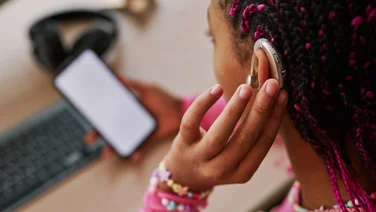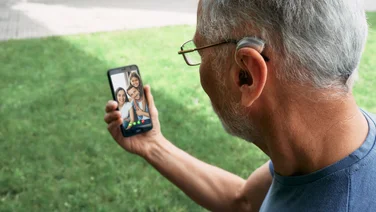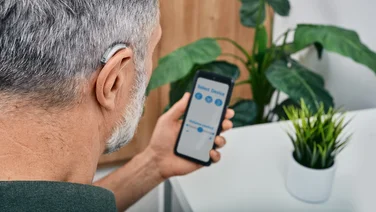To help us provide you with free impartial advice, we may earn a commission if you buy through links on our site. Learn more

Working out how to put hearing aids in can be a daunting experience for the uninitiated. After all, there’s an enormous number of products on the market, all with different hearing aid batteries, and to make matters worse, they aren’t all inserted into your ears in the same way.
If you don’t get it right the first time, though, don’t be discouraged. “As far as inserting the hearing aid,” explains audiologist Dr Ruth Reisman, “it does take some practice to get the earpiece into the ear properly.” She recommends trying to insert the hearing aid in front of a mirror for a visual steer, though warns that others may find it more intuitive to guide the earpiece in by touch alone.
It’s worth noting that the design of hearing aids can vary across the board, and if you are struggling to insert your hearing aids, check the manufacturer’s instructions or consult with an audiologist for further assistance.
Whether you’ve got mild, moderate or severe hearing loss, we’ve done a deep dive on the best way to insert the life-enhancing devices. Here’s our guide to putting hearing aids in, whether you have a smaller in-the-ear (ITE) hearing aid or a larger and typically more powerful behind-the-ear (BTE) model.
If you have an idea of your needs, you can use our free quote finder tool to be matched to a local hearing aid specalist.
READ NEXT: How do hearing aids work?
Get a free hearing aid quote today
Take our quick survey below and we’ll provide you with a quote for hearing aids that match your exact requirements.
How to put hearing aids in
How to put ITE hearing aids in
ITE or in-the-ear hearing aids sit entirely in the ear canal (like a pair of earbuds) and are typically more compact than BTE hearing aids (though they often have a correspondingly smaller battery). The first thing you should do is identify which hearing aid goes in the left or right ear: this will be indicated on the device, and lots of manufacturers use a red dot to indicate right (think “r” for “red’ and “right”) – and a blue dot to indicate left.
Though they differ from model to model, inserting an ITE hearing aid is a broadly uniform process. Simply take the hearing aid between your thumb and forefinger, and position the removal handle (the rigid extended tube used to remove the device from the ear) towards the bottom of your ear. With your other hand, carefully pull on the upper half of your ear to open the entryway to the ear canal.
Once opened, gently push the hearing aid into the ear canal and tuck the removal handle away from the ear canal, into the curvature or the “bowl” of your ear. You may need to lightly jostle the healing aid in your ear so that it nestles into place in your ear and sits comfortably – it should fit snugly.
READ NEXT: How much do hearing aids cost?
How to remove ITE hearing aids
When you want to remove your ITE hearing aid, simply grab the removal handle between your thumb and forefinger and gently pull the device out of your ear. It should release quickly, but if not you can rotate the device or use your opposite hand to gently pull your ear canal wider, freeing up the hearing aid.
How to put BTE hearing aids in
As with ITE hearing aids, you first have to identify which hearing aid is for the left ear and which is for the right. Many manufacturers indicate the right-hand side with a red dot (again, easily recalled by remembering the first letter of both words is “r”), whereas the left-hand side is marked by a blue dot.
If you have a BTE hearing aid with an earmold attached, the device will comprise three main components: the functional body of the hearing aid, which rests behind the ear; the plastic earpiece or earmold, moulded to fit your ear canal and concha bowl; and the hook, which connects the two and keeps the whole shebang on your ear.

The earpiece sits inside the user’s ear and is often made up of two separate parts: a rounded sound outlet that’s inserted into the ear canal, and a curved, smaller prong called the lock, which helps the hearing aid to stay put inside the user’s concha bowl (that’s the part of your ear that immediately surrounds your ear canal).
Resist the temptation to start by hooking the body of the hearing aid onto your ear before you’ve inserted the earpiece. Instead, start by holding the hearing aid by the moulded earpiece and slowly pressing it into your ear canal, pushing the lock in (if you have one) so that it nestles comfortably in your concha. The fit should be snug but not painful. Then, simply lift the hook over your ear so that the body of the hearing aid hangs behind the ear – just like putting on a pair of glasses.
How to remove BTE hearing aids
When you want to take your BTE hearing aid off, start by taking the earmold between your fingers and pulling it gently out of the ear canal and concha. You can then lift the hook and body up and over your ear.






